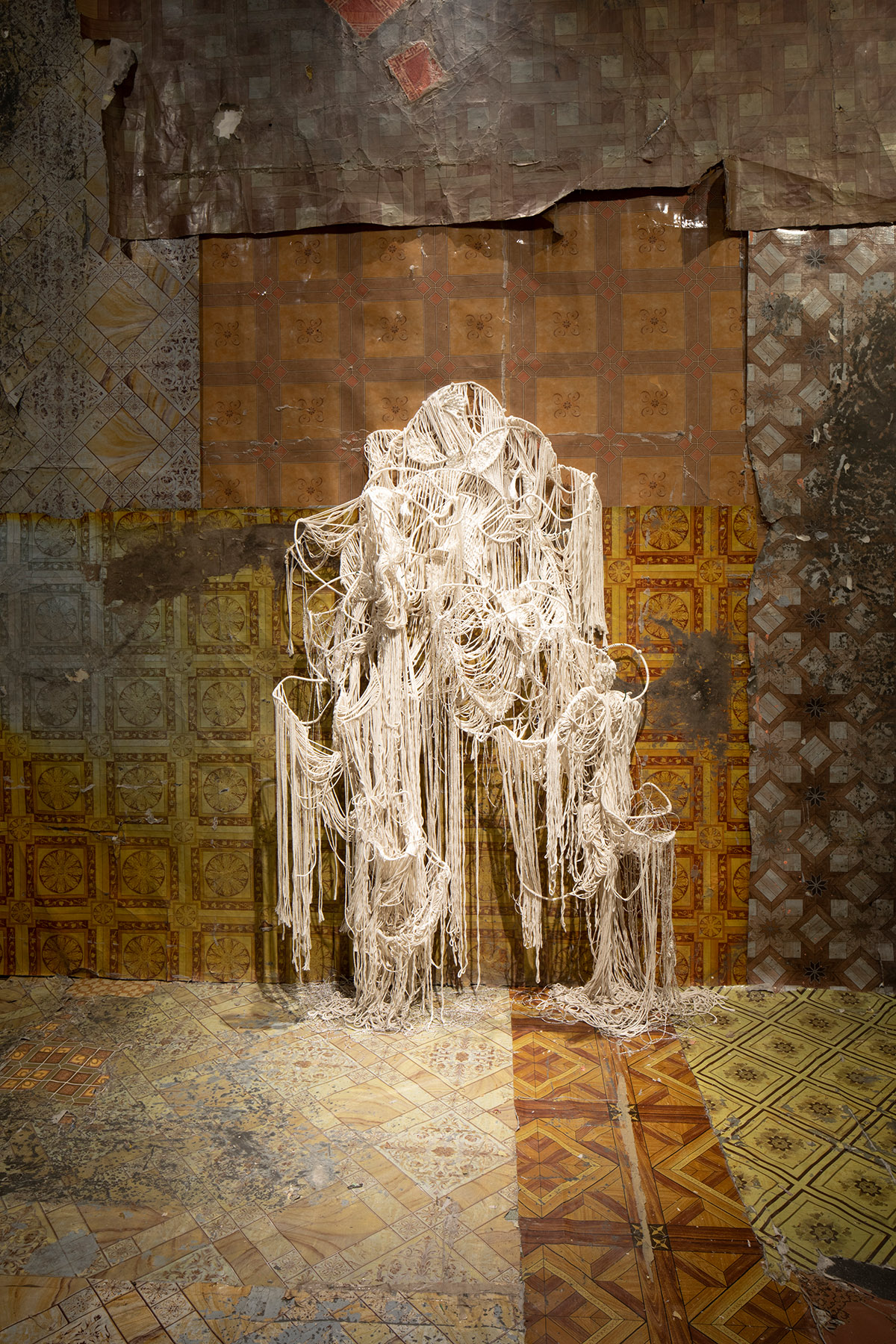Casey Kaplan


UNCANNY NOSTALGIA: IGSHAAN ADAMS’ “WHEN DUST SETTLES”
A review by Courtney Drysdale
10 July 2018
Igshaan Adams was brought up in Bonteheuwel, Cape Town by his Christian grandparents, but he is a practicing Muslim using his works to identify and comment on religion and sexuality. Adams often examines cultural hybridity and spirituality through the subtle interpretation and contestation of social and political boundaries. His new body of work, produced for the Standard Bank Young Artist Award is titled “When Dust Settles,” and was shown for the first time in the Gallery in the Round during this year’s National Arts Festival in Grahamstown.
The exhibition consists of large-scale sculptures made of wire, beads and white cotton thread, with others including face cloths. A large installation incorporates vinyl, layering the walls and floors with used and well-worn linoleum floor panels. The title itself is indicative of reflecting back on previous practices through new perspectives, with two performances involving his mother and brother that explore healing and catharsis.
The space is plated and layered in vinyl floor paneling, in an array of colours and patterns. There is a reminiscence of an earlier work by Adams from 2010 titled Vinyl at the AVA gallery in Cape Town, which also used the linoleum flooring. Here, the vinyl was sourced from various sections of the Cape Flats such as Bonteheuwel and Khayelitsha. It is an immersive environment: this vinyl has acted as a witness to Adams upbringing as well as many others across the Cape Flats. Scuffed and used, one becomes acutely aware of the lives that these pieces of vinyl have been witness to. This wear and tear are residues of love and care, but surely also of pain and struggle. A special kind of nostalgia resides with them and is amplified by the vinyl’s smell.
There is also a sweeter smell that gives this nostalgia more weight. In a little nook of the gallery stands three pots, at them is Adams’ mother and she is preparing and serving boeber. Visitors take some of the warm dessert and continue to drift around the exhibition, distinct wafts of cinnamon and cardamom join the warm space. Spread across the floors and up the sides of the walls there are anthropomorphic and ghostly white entanglements. Sculptures, constructed out of garden fences and white cotton thread, some show traces of Adams earlier weaving works, quietly hidden in the chaotic tangle.
Adams describes how he was lead to using a domestic object such as these garden fences because they are reminiscent of his grandmother’s garden. Immaculately tended, these fences demarcated the pristine space. They symbolized barriers from the inner and outer violence of everyday life experienced by Adams as a young homosexual man growing up in the 80s in South Africa.
Taking these symbols he warps them in to uncanny and sometimes figurative forms, which disrupt the vibrant colours and patterns of the vinyl. Adams has often stated that his work reflects his own hybridity in terms of religion, race and coloured culture. We see this in the way the sculptures interrupt the space. Adams uses these internal conflicts in a cathartic way with another performance, one where he and his brother wash and clean each other’s feet. The performance was unplanned. A cleansing of sorts, it illustrates a tremendous humility, one of the first teachings in Islam, and compassionate exchange of brotherhood between the two.
Much of Adams practice and this specific body of work has questioned these demarcations or boundaries, both internal and external, of the individual and collective. “Search,” which stood out for me in this regard, was hung separately, slightly aside from the other works. A tangle of wires and beads it looks like it has been sewn together from different parts. Adams commented that whenever he is creating artworks, there is a piece in the studio that may not necessarily be shown, but is being created nonetheless to work through an idea or develop a technique. Over time “Search” steadily accumulated its’ shape, informed by previous ideas in older exhibitions. It symbolizes a development that is reflected in the exhibition as a whole as well as how it will change and adapt as it moves to different locations across the country over the year. Such as the title of the exhibition “When Dust Settles” suggests a possible ending, it also implies the complexity and variation of form that Adams’ grapples with, or maybe even a beginning.